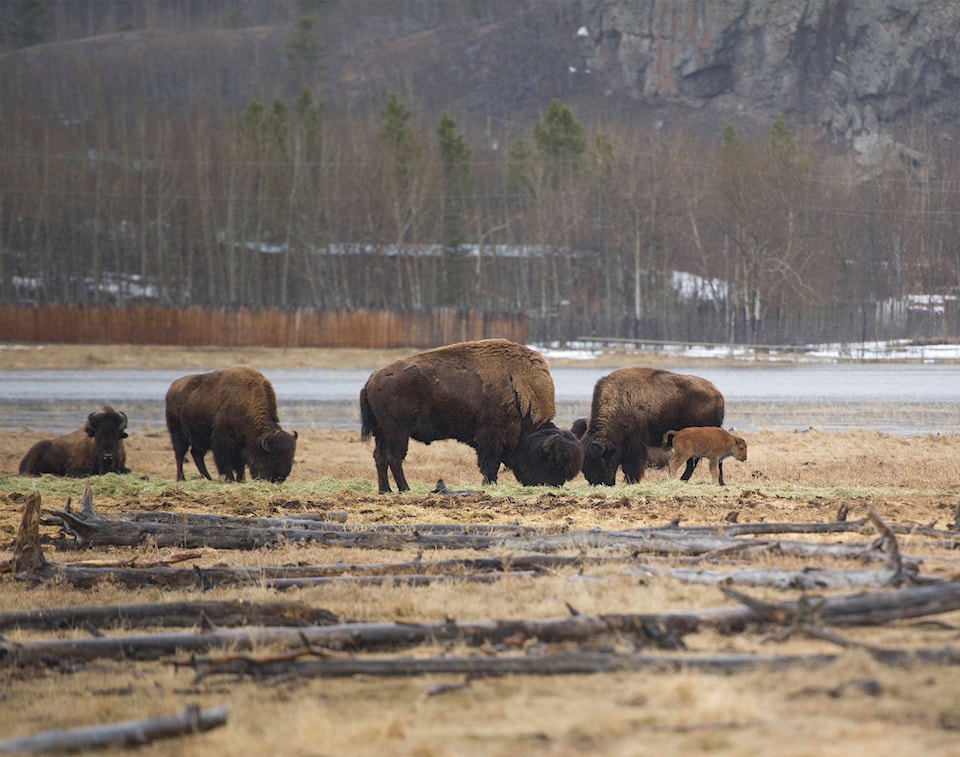Staff at the Yukon Wildlife Preserve were in for an exciting surprise on April 22. It was a normal morning, until they reached the home of the bison, where a bison calf was observed.
The arrival of the bison calf came two weeks earlier than the 2020 baby, but Jake Paleczny, the Yukon Wildlife Preserve executive director, said the early arrival isn’t unheard of.
“This is about right for bison,” said Paleczny. “If we had had muskox babies, which we won’t this year, but maybe next year, we’ve had them as early as early April. It’s not unusual for bison, normally it is the first week of May, but this very typical.”
Paleczny said it is “difficult to tell if they are pregnant from a distance” which is why the baby was a welcomed surprise. At the wildlife preserve, Paleczny said they won’t go in to check to see if the animals are pregnant.
“To go find out is a stressful experience,” said Paleczny. “To get up close to animals that are not humanized, like these ones, requires drugs and putting them to sleep — that’s stress they just don’t need.”
Along with the joy of seeing the new baby, Paleczny said there are some anxious moments as well.
“It is a combination of exciting and a little bit stressful in the early days,” he said. “You see the baby is there but you are looking to see how it is doing, is it standing up, is it walking fine? In some cases, if something is not going well we will step in and intervene.
“We have to be ready to do that, so there is some apprehension along with that. It is a fine balance between making sure they have great care and welfare, that they are happy and healthy animals, but, we don’t want to cause them unnecessary stress.
“Different zoological institutions approach that in different ways. We are so lucky to have the land base that we have that we can take a much more hands-off approach than many other institutions. That’s what makes the Yukon Wildlife Preserve such an interesting place.”
It is the first bison of the season, but Paleczny said it will almost certainly not be the last. At the wildlife preserve, he said they will continue to allow the herd to raise the calves as they would in the wild.
Paleczny was right. The wildlife preserve welcomed its second happy, healthy baby bison on the morning of May 1.
“They know how to be parents. They have the babies by themselves and raise the babies by themselves. They really don’t need us getting in the way. How many babies we will see exactly we don’t know, but it will be a pleasant surprise.”
The gender of the bison is yet to be determined, but Paleczny said they will have some ideas in the coming days.
“At some point, we will find out,” said Paleczny. “With all of our animals, we do eventually have to ensure they have some form of identification. At some point, we will be doing a hands-on check-in.”
Paleczny said, “things are going great so far” in regards to the baby bison and he hopes the “great start” continues through the rutting season.
Bison weren’t the only animals at the reserve getting busy. More species are expected to have babies this year.
“It is really exciting when the baby season starts,” said Paleczny. “It is the first one of the season but almost certainly not the last. We are expecting to see a few more bison and we should see caribou babies by early June and this year, a fun and exciting one is baby lynx.
“We had our male and female lynx together, our male and two females, and we are expecting, hoping babies will be born mid-May.
“For lynx, they are born with their eyes closed. They are really helpless at birth and will be in the den with their mom for the first couple of weeks. It is only 10-12 days after they are born that they start even opening their eyes.
“Hopefully by mid-June people can get a look at the baby lynx.”
The wildlife preserve only has one habitat for the bison so they are always together, but for other species, like the lynx and caribou, the males and females are separated.
“We are following a collection plan to ensure we maintain healthy populations that have a good diversity of genetics, genders, ages – you don’t want all of your animals getting old at the same time,” said Paleczny.
“That is important because there are nearly 200 animals here at the Wildlife Preserve. You got to be careful and thoughtful about how you maintain those animals.
“With the bison, in their case, we have only a single habitat for the bison so they are always together.
“Something like lynx, for example, we put them together because we knew it was time. For caribou, we’ve been working on breeding caribou for a couple of years now.”
Paleczny said he and all the staff at the Yukon Wildlife Preserve are excited for the babies being born this year and are looking forward to showing the public the young ones.
Contact John Tonin at john.tonin@yukon-news.com
